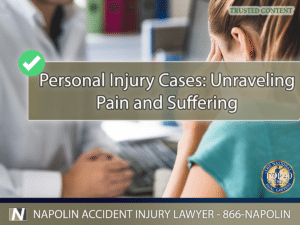Your Rights in Personal Injury Cases: Unraveling Pain and Suffering
Introduction to Your Rights in Personal Injury Cases Unraveling Pain and Suffering
In the legal world of personal injury cases, a term you will often hear is “pain and suffering”. This term holds a lot of weight when it comes to determining the compensation a victim is eligible to receive. To better understand how this can impact a personal injury case, we will delve into what exactly pain and suffering entails.
Understanding Pain and Suffering
“Pain and suffering” is a legal term describing the physical and mental distress caused by an injury. It's a crucial element in many personal injury cases. Broadly, pain and suffering can be categorized into two types: physical and mental. Physical pain and suffering pertain to an injury victim's actual physical injuries, such as pain or a disability. Mental pain and suffering refer to any negative psychological impacts due to the injury like anxiety, depression, loss of enjoyment of life, or even post-traumatic stress disorder (PTSD).

Importance of Pain and Suffering in Personal Injury Cases
Importance of Pain and Suffering in Personal Injury Cases
The concept of pain and suffering is integral to personal injury cases. It plays a significant role in determining the amount of compensation a victim may receive. For instance, consider a person who has been in a car accident and sustained a broken leg. The medical expenses, lost wages due to absence from work, and costs for rehabilitation would be fairly straightforward to calculate. However, the pain endured by the victim during recovery, the mental anguish of not being able to walk, and the inconvenience of depending on others for everyday tasks could qualify for pain and suffering damages.
How to Prove Pain and Suffering
Proving pain and suffering can be complex, but it is essential in securing fair compensation. Some of the ways to prove this include medical records that detail the physical injuries, testimonies from mental health professionals about any psychological trauma, and the victim's personal narrative of their daily life struggles after the injury. Lawyers play a vital role here, as they help piece together the evidence and present a compelling case for pain and suffering.

Calculating Pain and Suffering Compensation
Calculating Pain and Suffering Compensation
There are generally two methods used to calculate pain and suffering: the multiplier method and the per diem method. The multiplier method involves adding up all actual damages (like medical bills and lost wages) and multiplying that sum by a certain number, usually between 1.5 and 4. The per diem method assigns a certain dollar amount for each day the victim suffered from the date of the accident until they reached maximum recovery. Each case is unique, and the choice of method often depends on the specific circumstances.
Limitations on Pain and Suffering Claims
In some situations, there might be limits on pain and suffering claims. These limitations often depend on the specifics of the case, such as the type of injury, the state's laws, and whether the victim had any role in causing the accident. Understanding these limitations can be crucial in managing expectations for a personal injury claim.
How Napolin Accident Injury Lawyer Can Help
We, at Napolin Accident Injury Lawyer, dedicate ourselves to assist victims in navigating these complex waters. Our extensive litigation experience helps us build a compelling case for our clients, ensuring they receive the compensation they rightfully deserve for their pain and suffering.

Your Rights in Personal Injury Cases – Unraveling Pain and Suffering
Conclusion to Your Rights in Personal Injury Cases Unraveling Pain and Suffering
Navigating a personal injury case can be challenging. Understanding the concept of pain and suffering, its importance, and how it's proven and calculated, can significantly impact the outcome of a case. And while there may be limitations on pain and suffering claims, knowing how to navigate these restrictions is essential. That's where we step in. At Napolin Accident Injury Lawyer, we have extensive litigation experience in handling personal injury cases, and we're ready to help you assert your rights
